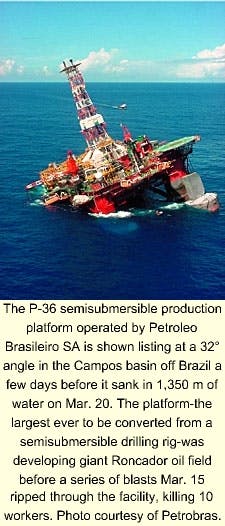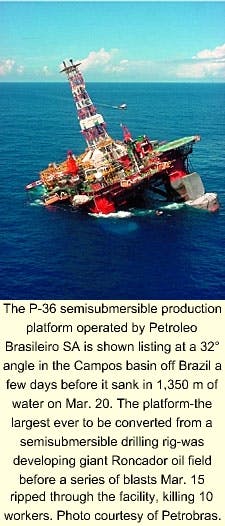Concerns over a possible worsening oil spill are the latest repercussions from the worst offshore oil industry disaster in years, the loss of the P-36 semisubmersible production platform in the Campos basin off Brazil earlier this month.
The platform, the largest producing facility ever converted from a semisubmersible drilling rig, was rocked by massive explosions Mar. 15, killing at least 10 workers and injuring several others (OGJ, Mar. 19, 2001, Newsletter, p. 5).
Despite desperate attempts to right and then keep afloat the massive facility, the platform sank to the seabed in 1,350 m of water last week.
When the accident occurred, the facility had been producing 84,000 b/d of crude oil and 1.3 million cu m/day of natural gas in giant Roncador field in the Campos basin, 80 miles off Rio de Janeiro (OGJ, Sep. 20, 1999, p. 33).
Operator Petroleo Brasileiro SA (Petrobras) was scheduled to receive a special award at this year's upcoming Offshore Technology Conference in Houston for technological achievement in Roncador field, where it has logged a number of deepwater records.
Spill concerns
Petrobas said Mar. 21 that possibly all of the crude oil and diesel stored aboard the platform has already leaked from it.
Irani Carlos Varella, Petrobas executive manager for environment and security, said the P-36 contained 300,000 l. of crude in its risers and 1.2 million l. of diesel fuel in its storage tanks.
The storage tanks probably burst because of the water pressure at that depth, Varella added.
He told OGJ Online in a telephone interview that he does not foresee any possibility of spilled oil or diesel fuel contaminating beaches or mangrove swamps nearby. Prevailing winds are expected to blow any spilled oil out to sea.
Petrobras estimated a visible slick on the water surface at presstime contained 11,000 l. of oil or diesel fuel.
All 21 producing wells had been shut in before the platform was evacuated.
Petrobras had 26 ships on standby at the platform site, some of them with oil spill booms, dispersants, and suction pumps. Bad weather may hamper recovery efforts. Waves of 1.8 m were reported.
Platform sinking
The explosions knocked out a support pillar, but Petrobras officials had said during the weekend following the accident that the platform was stabilized.
Petrobras said there had been a gas leak that escaped into the column where the blasts took place, but it had no explanation as to the cause.
The platform shifted suddenly early Mar. 20 and was listing at a 32° angle before it slipped beneath the ocean surface (see photo). High winds and rough seas were blamed.
The government said Petrobras has been ordered to prepare a report on the sinking in 30 days.
Petrobras engineers have said it will be virtually impossible to salvage the platform, because of the extreme water depths and massive platform size.
Roncador is a 132 sq km structure that holds oil reserves estimated at 3 billion boe. It has the world's deepest offshore producing well-producing 20,000 b/d of crude oil-in 1,853 m of water.
Discovered in October 1996 with the 1-RJS-436 wildcat, Roncador lies in 1,500-2,000 m of water northeast of Albacora and Frade fields.



